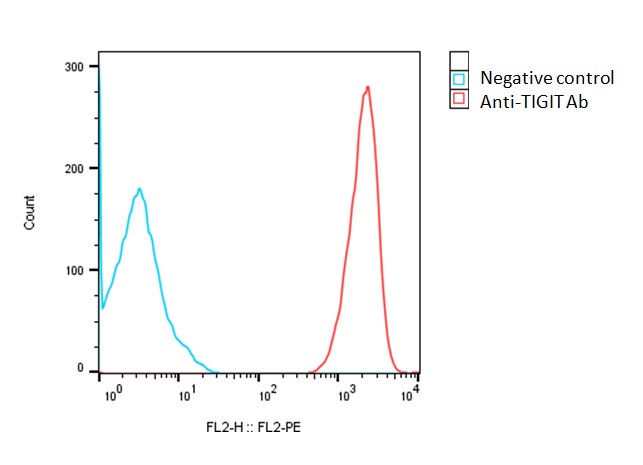
| Catalog Number | Product | Size | Price | |
|---|---|---|---|---|
| C3020 | Human TIGIT-CHO-K1 Stable Cell Line | 2 vials | $3950 | Order |
| Catalog Number | C3020 |
|---|---|
| Cell Line Name | Human TIGIT-CHO-K1 Stable Cell Line |
| Accession Number | NM_173799.4 |
| Host Cell | Adherent CHO-K1 |
| Quantity | Two vials of frozen cells (2x106 per vial) |
| Culture Medium | DMEM with 10% FBS, 4 ug/ml puromycin |
| Freezing Medium | 90% FBS and 10% DMSO |
| Storage | Liquid nitrogen upon receipt |
| Product Datasheet: | Download PDF |
Detection of human TIGIT expression on human TIGIT-CHO-K1 stable cells using a monoclonal antibody specific for human TIGIT (Cat #A1014)

Human T-cell immunoreceptor with Ig and ITIM domains (TIGIT) is a cell surface protein and plays a role as a crucial inhibitory immune checkpoint. TIGIT is a member of the PVR-like protein family in the immunoglobulin superfamily and is expressed on various immune cells, including CD4+ and CD8+ T cells, regulatory T cells, natural killer (NK) cells, and dendritic cells (DCs). TIGIT is expressed in various tissues, including lymphoid tissues, spleen, thymus, lung, and liver. In cancers, TIGIT expression has been observed in various solid tumors, including lung cancer, melanoma, ovarian cancer, and breast cancer. In these tumors, TIGIT expression has been associated with immune evasion and resistance to immune checkpoint blockade therapy. TIGIT binds to CD155 (PVR, Necl-5), CD112 (PVRL2, Nectin-2), and CD113, but with much higher affinity to CD155, which is expressed on dendritic cells (DCs), T cells, B cells, macrophages, endothelial cells, and tumor cells. The binding of TIGIT to its ligands results in the inhibition of T-cell activation, leading to immune suppression. Moreover, TIGIT also binds to CD226 (DNAM-1), an activating receptor that promotes T-cell activation. Due to its role in immune regulation and its expression in cancers, TIGIT has emerged as a promising therapeutic target for cancer immunotherapy.
Yu X, Harden K, Gonzalez LC, et al. Nat Immunol. 10:48-57. 2009.
Johnston RJ, Comps-Agrar L, Hackney J, et al. Cancer Cell. 26:923-937. 2014.
Harjunpää H, Guillerey C. Clin Exp Immunol. 200:108-119. 2020.
Ge Z, Peppelenbosch MP, Sprengers D, Kwekkeboom J. Front Immunol. 12:699895. 2021.